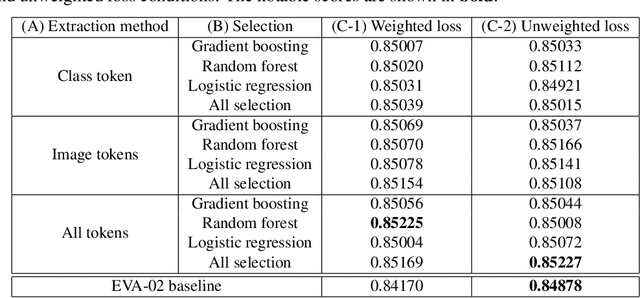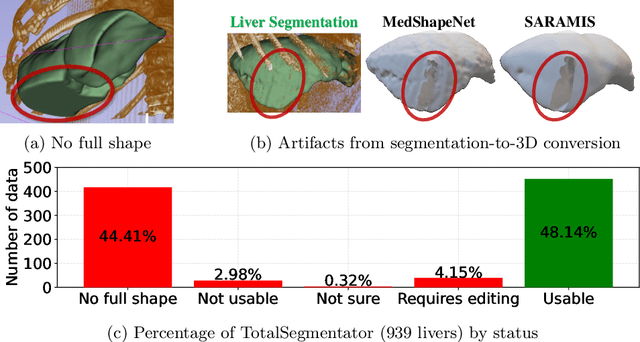Khoa Tuan Nguyen
Towards Improved Cervical Cancer Screening: Vision Transformer-Based Classification and Interpretability
Apr 30, 2025



Abstract:We propose a novel approach to cervical cell image classification for cervical cancer screening using the EVA-02 transformer model. We developed a four-step pipeline: fine-tuning EVA-02, feature extraction, selecting important features through multiple machine learning models, and training a new artificial neural network with optional loss weighting for improved generalization. With this design, our best model achieved an F1-score of 0.85227, outperforming the baseline EVA-02 model (0.84878). We also utilized Kernel SHAP analysis and identified key features correlating with cell morphology and staining characteristics, providing interpretable insights into the decision-making process of the fine-tuned model. Our code is available at https://github.com/Khoa-NT/isbi2025_ps3c.
Boosting 3D Liver Shape Datasets with Diffusion Models and Implicit Neural Representations
Apr 28, 2025



Abstract:While the availability of open 3D medical shape datasets is increasing, offering substantial benefits to the research community, we have found that many of these datasets are, unfortunately, disorganized and contain artifacts. These issues limit the development and training of robust models, particularly for accurate 3D reconstruction tasks. In this paper, we examine the current state of available 3D liver shape datasets and propose a solution using diffusion models combined with implicit neural representations (INRs) to augment and expand existing datasets. Our approach utilizes the generative capabilities of diffusion models to create realistic, diverse 3D liver shapes, capturing a wide range of anatomical variations and addressing the problem of data scarcity. Experimental results indicate that our method enhances dataset diversity, providing a scalable solution to improve the accuracy and reliability of 3D liver reconstruction and generation in medical applications. Finally, we suggest that diffusion models can also be applied to other downstream tasks in 3D medical imaging.
Towards Abdominal 3-D Scene Rendering from Laparoscopy Surgical Videos using NeRFs
Oct 18, 2023Abstract:Given that a conventional laparoscope only provides a two-dimensional (2-D) view, the detection and diagnosis of medical ailments can be challenging. To overcome the visual constraints associated with laparoscopy, the use of laparoscopic images and videos to reconstruct the three-dimensional (3-D) anatomical structure of the abdomen has proven to be a promising approach. Neural Radiance Fields (NeRFs) have recently gained attention thanks to their ability to generate photorealistic images from a 3-D static scene, thus facilitating a more comprehensive exploration of the abdomen through the synthesis of new views. This distinguishes NeRFs from alternative methods such as Simultaneous Localization and Mapping (SLAM) and depth estimation. In this paper, we present a comprehensive examination of NeRFs in the context of laparoscopy surgical videos, with the goal of rendering abdominal scenes in 3-D. Although our experimental results are promising, the proposed approach encounters substantial challenges, which require further exploration in future research.
RLCorrector: Reinforced Proofreading for Connectomics Image Segmentation
Jun 10, 2021



Abstract:The segmentation of nanoscale electron microscopy (EM) images is crucial but challenging in connectomics. Recent advances in deep learning have demonstrated the significant potential of automatic segmentation for tera-scale EM images. However, none of the existing segmentation methods are error-free, and they require proofreading, which is typically implemented as an interactive, semi-automatic process via manual intervention. Herein, we propose a fully automatic proofreading method based on reinforcement learning. The main idea is to model the human decision process in proofreading using a reinforcement agent to achieve fully automatic proofreading. We systematically design the proposed system by combining multiple reinforcement learning agents in a hierarchical manner, where each agent focuses only on a specific task while preserving dependency between agents. Furthermore, we also demonstrate that the episodic task setting of reinforcement learning can efficiently manage a combination of merge and split errors concurrently presented in the input. We demonstrate the efficacy of the proposed system by comparing it with state-of-the-art proofreading methods using various testing examples.
 Add to Chrome
Add to Chrome Add to Firefox
Add to Firefox Add to Edge
Add to Edge